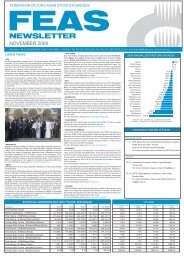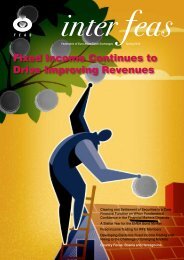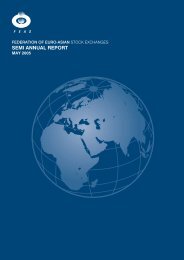Download - FEAS
Download - FEAS
Download - FEAS
You also want an ePaper? Increase the reach of your titles
YUMPU automatically turns print PDFs into web optimized ePapers that Google loves.
FEDERATION OF EURO-ASIAN STOCK EXCHANGES SEMI ANNUAL REPORT OCTOBER 2005<br />
WORLD FEDERATION OF EXCHANGES<br />
Thomas Krantz<br />
Secretary General<br />
THE SIGNIFICANCE OF THE<br />
EXCHANGE INDUSTRY<br />
At the Heart of the World Economy<br />
Since the end of the 1980s, regulated securities<br />
and derivatives exchanges have come to play a<br />
major new role in international finance. That<br />
role is qualitatively different from anything seen<br />
since World War II. Quantitatively, the markets<br />
operated by exchanges have grown to a scale<br />
unimagined before, positioning them at the<br />
heart of the world economy. This remains true<br />
despite current macroeconomic difficulties<br />
covering large parts of the world. The active<br />
confrontation of buy and sell orders on a public<br />
market determines corporate asset values in a<br />
manner that is fair and visible to all.<br />
Exchanges have made this business growth<br />
possible, and the size of their industry has<br />
changed their position within the international<br />
economy. They have done this by:<br />
• aligning their corporate strategies with<br />
the business potential<br />
• adapting the rules for trading access and<br />
listing of securities<br />
• training their staff and investing in<br />
infrastructure<br />
• boosting the commerce of finance with<br />
new telecom and computer technologies<br />
• providing stimulus for trading and<br />
improved risk management through<br />
derivatives markets<br />
• supporting pension and retirement<br />
savings schemes<br />
• participating in the reorientation of finance<br />
from bank loans into securities<br />
• promoting the increase in cross-border<br />
investment and trading<br />
This expansion in the work of regulated<br />
exchanges coincided with a trend in the late<br />
1990s leading many bourses to switch from a<br />
business structure based on broker<br />
cooperatives with member broker/bank<br />
ownership to for-profit limited companies with<br />
outside owners. For most of the Federation’s<br />
members, business objectives changed with<br />
this new governance form. The heightened<br />
commercial feel of this industry also affected<br />
those exchanges maintaining their mutual legal<br />
form, and they have proven themselves to be<br />
successful competitors. The dynamism of<br />
these businesses is one reason for the<br />
qualitative difference in the role of exchanges in<br />
this century: the markets could not have grown<br />
in scale to the extent they did, even considering<br />
the current downturn, if their operations were<br />
not of high quality, and recognized as being<br />
the most efficient venue for listing and trading<br />
of securities and standardized derivative<br />
instruments.<br />
Exchanges are visibly identified with the<br />
commercial spirit of the times. Exchanges<br />
symbolize market capitalism. The level of their<br />
activities gives an instant short-hand summary<br />
of entire nations’ socioeconomic health. It is<br />
PAGE 28<br />
As a social responsibility, and as an<br />
essential part of further business<br />
development, exchange managers come<br />
forward as leaders in public debates on<br />
capital markets, and to correct inaccuracies<br />
in the discussions about regulated bourses.<br />
natural that these enterprises be managed as<br />
dynamic businesses in their own right, enabling<br />
them to meet the commercial demands of the<br />
markets.<br />
The Transformed Position of Exchanges<br />
In December 1990, the World Federation of<br />
Exchanges (formerly FIBV) counted 38<br />
members. The total market capitalization of<br />
equities listed on these bourses was US$ 9,400<br />
billion, and the value of share trading for the<br />
year hit US$ 6,211 billion.<br />
By June 2003, the Federation had grown to 56<br />
members. Total market capitalization had risen<br />
to US$ 25,481 billion, after reaching a high<br />
point in March 2000 of US$ 36,286 billion. The<br />
value of share trading during 2002 fell back to<br />
US$ 33,453 billion, compared to the previous<br />
year’s US$ 41,225 billion, and on an annualized<br />
basis stood at US$ 30,748 billion in June 2003.<br />
While the business environment is difficult, the<br />
charts show that the long-term growth trend of<br />
increasing public reliance on capital market<br />
financing remains intact. Like the underlying<br />
growth in the economies themselves, this<br />
upward trend remains subject to fluctuation.<br />
This long-term trend translated into:<br />
• growth in equity market capitalization over<br />
the period of 171%<br />
•growth in trading volumes of 395%<br />
•acceleration in the annual turnover velocity<br />
of shares from 66% to 121%, doubling the<br />
liquidity provided on regulated exchanges.<br />
Enhanced business profitability, privatizations,<br />
IPOs, indexes and derivative products, and<br />
cross-border trading fed this transformation.<br />
The exchanges were key actors which adapted,<br />
invested, participated and enabled this to take<br />
place.<br />
The Scale of Regulated Exchanges<br />
By all measures, the health of an exchange is<br />
vital to a market economy. As a percentage of<br />
gross domestic product, the value of equity<br />
market capitalization of Federation member<br />
exchanges varied from a low of 9% to a high of<br />
313% at the end of 2001, the last year for which<br />
the IMF’s GDP statistics have been provided.<br />
The global average market capitalization for<br />
equities on members’ exchanges was 73% of<br />
GDP in 2001. Moreover, these assets include<br />
most of the world’s most highly prized<br />
companies.<br />
At the end of 1991, 25,980 foreign and<br />
domestic companies were listed on member<br />
exchanges. Ten years later, at the end of 2002,<br />
this number had grown to 38,333. The world’s<br />
corporations favor this source of funding, and<br />
economic theory and practice confirm the<br />
efficiency of this form of capital financing.<br />
In 1999, companies and governments raised<br />
new capital on Federation member exchanges<br />
amounting to US$ 754 billion, and this<br />
increased to US$ 896 billion in 2000 under<br />
market conditions that were becoming less<br />
favorable. The figures for fresh capital raised<br />
have dropped steeply since, to US$ 342 billion<br />
in 2001 and US$ 262 billion in 2002. But these<br />
amounts remain very significant economically.<br />
Economic reliance on exchanges is one of the<br />
key changes in finance over the last decade.<br />
Public policy makers, corporations, and the<br />
saving public have come to appreciate the<br />
importance of these figures as the historical<br />
trend remains striking.<br />
Moreover, in many parts of the world, exchange<br />
index movements have come to be integrated<br />
into the rhythm of daily life, every few minutes<br />
on the radio, at regular intervals on television,<br />
and constantly on the Internet. The capital<br />
markets have given rise to considerable<br />
expansion of the specialized printed press, too.<br />
The names of broad equity market indices are<br />
commonly recognized as being of social<br />
importance. When the market moves more than<br />
a few percent up or down, it is big national<br />
news. When exchange trading is interrupted for<br />
whatever reason, that too is major news.<br />
Clearly, a different kind of financial business<br />
has emerged on the scene. No other actor has<br />
such an affect on the public mind, and that,<br />
too, is meaningful.<br />
This heightened reliance on public capital<br />
markets has been taking place in many<br />
countries around the world, involving by far the<br />
greater part of the world’s economic life.<br />
Exchanges’ centrality to social wealth creation<br />
is established. Corporate treasurers need to<br />
factor in their ability to tap this source of cash<br />
by issuing securities, just as finance ministers<br />
try to balance national budgets with their<br />
privatizations of state-owned businesses.<br />
Public awareness of the need to invest has<br />
prompted great individual interest in equities<br />
and related exchange-traded products, too.<br />
A further benefit has been the broadening of<br />
share ownership, and with it the loosening of<br />
market forces for better corporate governance<br />
practices.<br />
Exchanges Establish Fair Rules for Efficient<br />
Markets<br />
Exchanges have a distinct, market-neutral<br />
identity within the financial services sector.<br />
They are not insurance companies, investment<br />
firms, banks, or brokerages. They operate<br />
regulated securities and derivative markets.<br />
These markets establish asset values through<br />
efficient price discovery, enabling the public to<br />
know how much companies are worth<br />
according to the latest news and economic<br />
outlook.<br />
Putting together rules, know-how and<br />
technology for transparent trading of assets<br />
worth three quarters of one year of the world’s<br />
GDP is quite a responsibility; to meet that<br />
challenge is to assist in building prosperity.<br />
Regulated securities exchanges provide
















